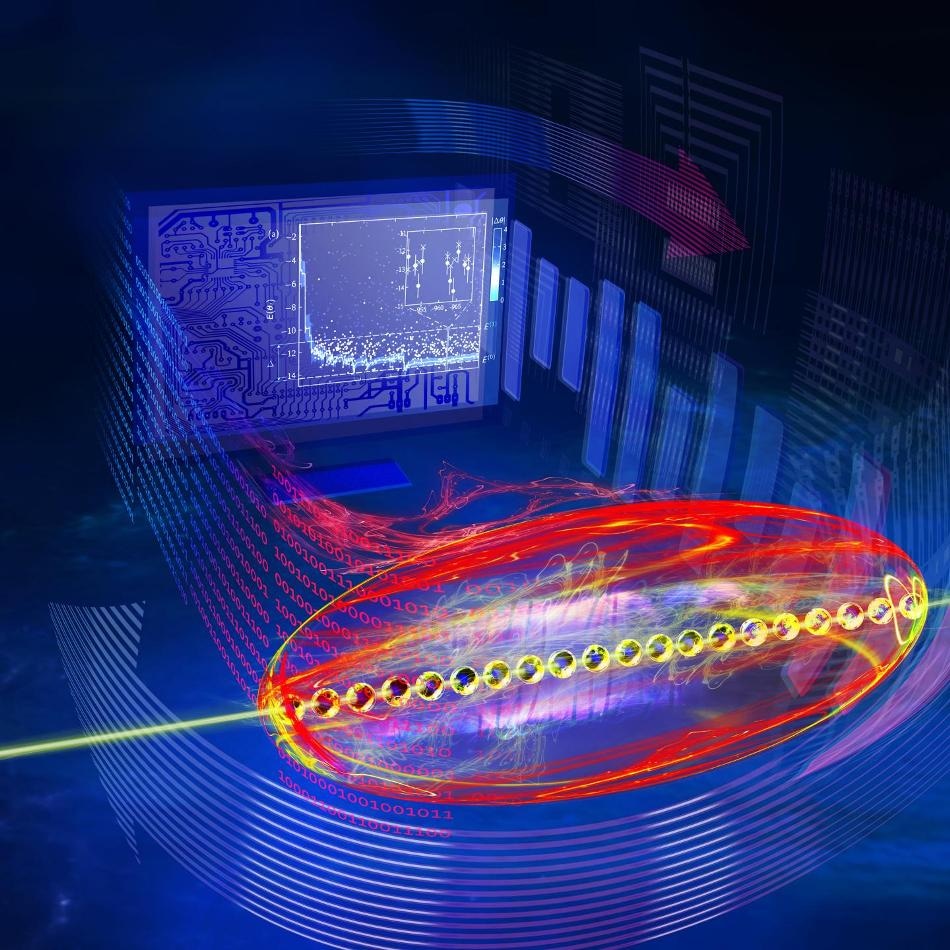May 16 2019
At present, several researchers are striving to explore how quantum advantage can be made use of on already existing hardware. The spontaneous formation of a pair of elementary particles was first simulated by physicists at the University of Innsbruck with the help of a digital quantum computer.
 A new method enables powerful quantum simulation on hardware available today. (Image credit: IQOQI Innsbruck/Harald Ritsch)
A new method enables powerful quantum simulation on hardware available today. (Image credit: IQOQI Innsbruck/Harald Ritsch)
However, as a result of the error rate, a large number of quantum bits would be required for more complex simulations, though the quantum bits are not yet available in the existing quantum computers. Moreover, the analog simulation of quantum systems in a quantum computer has narrow limits. Christian Kokail, Christine Maier, Rick van Bijnen, and colleagues from the Institute of Quantum Optics and Quantum Information (IQOQI) of the Austrian Academy of Sciences have used a new technique and surpassed these limits.
The researchers used a programmable ion trap quantum computer including 20 quantum bits as a quantum coprocessor, where the quantum mechanical calculations that attain the limits of classical computers are outsourced.
We use the best features of both technologies. The quantum simulator takes over the computationally complex quantum problems and the classical computer solves the remaining tasks.
Christine Maier, Experimental Physicist, IQOQI, Austrian Academy of Sciences
Toolbox for Quantum Modelers
The researchers used the variational technique from theoretical physics; however, they applied it on their quantum experiment.
The advantage of this method lies in the fact that we can use the quantum simulator as a quantum resource that is independent of the problem under investigation. In this way we can simulate much more complex problems.
Rick van Bijnen, IQOQI, Austrian Academy of Sciences
A simple comparison illustrates the difference: an analog quantum simulator is similar to a doll’s house; it depicts reality. By contrast, the programmable variational quantum simulator provides individual building blocks that can be used to build several different houses. In the case of quantum simulators, these building blocks are single spin rotations and entanglement gates. Using a classical computer, this set of knobs can be tuned until the desired quantum state is realized.
In order to achieve this, the physicists have created an advanced optimization algorithm that, in almost 100,000 requests of the quantum coprocessor by the classical computer, leads to the result. Together with the quantum experiment’s very fast measurement cycles, the simulator at IQOQI Innsbruck turns out to be tremendously powerful. For the first time, the spontaneous creation and destruction of pairs of elementary particles have been simulated by the physicists in a vacuum on 20 quantum bits.
As the new technique is extremely efficient, it is also possible to use it on larger quantum simulators. In the near future, the Innsbruck physicists intend to create a quantum simulator with nearly 50 ions. This paves the way for intriguing points of view for further analyses of solid-state models and high-energy physics problems.
Built-In Self-Check
The verification of the results of simulation is a previously unsolved problem in complex quantum simulations.
Such calculations can hardly or not at all be checked using classical computers. So how do we check whether the quantum system delivers the right result. We have solved this question for the first time by making additional measurements in the quantum system. Based on the results, the quantum machine assesses the quality of the simulation.
Christian Kokail, Theoretical Physicist, IQOQI, Austrian Academy of Sciences
A verification mechanism such as this is the precondition for much more complex quantum simulations since there is an abrupt increase in the essential number of quantum bits. “We can still test the simulation on 20 quantum bits on a classical computer, but with more complex simulations this is simply no longer possible,” stated Rick van Bijnen. “In our study, the quantum experiment was even faster than the control simulation on the PC. In the end, we had to take it out of the race in order not to slow down the experiment,” said the physicist.
Innsbruck Quantum Cloud
This success in research is based on the exclusive collaboration between theory and experiment at the Innsbruck quantum research center. The skill set from several years of experimental quantum research meets novel theoretical ideas in Tyrol, Austria. Collectively, this paves the way to results that are acknowledged worldwide and demonstrates a globally pioneering position of Innsbruck’s quantum research.
“15 years of very hard work have gone into this experiment,” reiterates Rainer Blatt, an experimental physicist. “It is very nice to see that this is now bearing such beautiful fruit.” According to Peter Zoller, a theoretical physicist, “We in Innsbruck are not only leaders in the number of available quantum bits, but have now also advanced into the field of programmable quantum simulation and were able to demonstrate for the first time the self-verification of a quantum processor. With this new approach, we are bringing the simulation of everyday quantum problems within reach.”
The study, which has now been published in Nature, was funded by the Austrian Science Fund FWF and the European Union, among others.